Home / Cyclohexane Chair Conformation Stability: Which One Is Lower Energy?
Conformations and Cycloalkanes
Cyclohexane Chair Conformation Stability: Which One Is Lower Energy?
Last updated: November 21st, 2024 |
Finding The Most Stable Conformation Of A Cyclohexane Chair
You’re given a structure with two or more substituents on a cyclohexane ring, and you’re asked to draw the most stable conformation. How do you do that? That’s what this post is about.
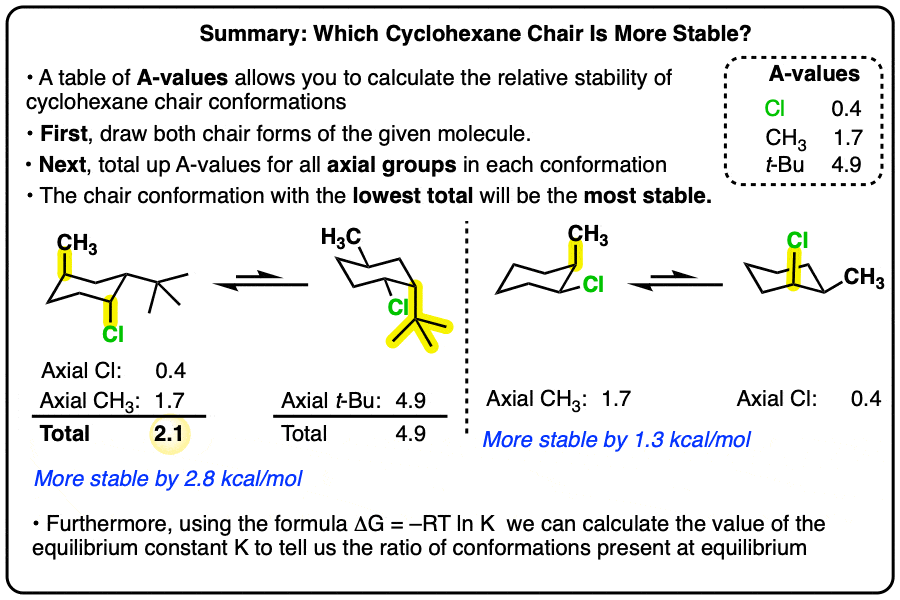
Table of Contents
- A-Values Are A Useful Measure of Bulkiness
- A-Values Are Additive
- Example: Determining The Most Stable Conformation Of cis– And trans- 1,2-Dimethylcyclohexane
- To Determine Chair Conformation Stability, Add Up The A-Values For Each Axial Substituent. The Lower The Number, The More Stable It is.
- Summary: Stability of Cyclohexane Conformations
- Notes
- Quiz Yourself!
- (Advanced) References and Further Reading
1. A-Values Are A Useful Measure Of Bulkiness
In the last post, we introduced A values and said they were a useful tool for determining which groups are “bulkiest” on a cyclohexane ring. (See post: Ranking the Bulkiness Of Substituents On Cyclohexane Rings With A-Values)
The greater the A-value (bulk), the more favoured the equatorial conformer will be (versus axial). We saw that hydroxyl groups (OH) have a relatively low A-value (0.87), methyl groups are higher (1.70) and the t-butyl group is one of the highest of all (>4.5) .
We also saw that by knowing the A value (which is essentially the energy difference in kcal/mol) we could figure out the % of axial and equatorial conformers in solution using the formula ΔG = –RT ln K
In this post we’re going to extend this concept and see what happens when we have MORE than one group on a cyclohexane ring.
2. A-Values Are Additive
The nice thing about A values is that they are additive. We can make the (safe) assumption that groups on adjacent carbons don’t bump into one another [Note 1] so figuring out the torsional strain of a cyclohexane chair is simply a matter of adding up the A values of the axial groups in any chair conformation.
We can apply this to cyclohexanes with two, three, or even more substituents.
Here are some examples:
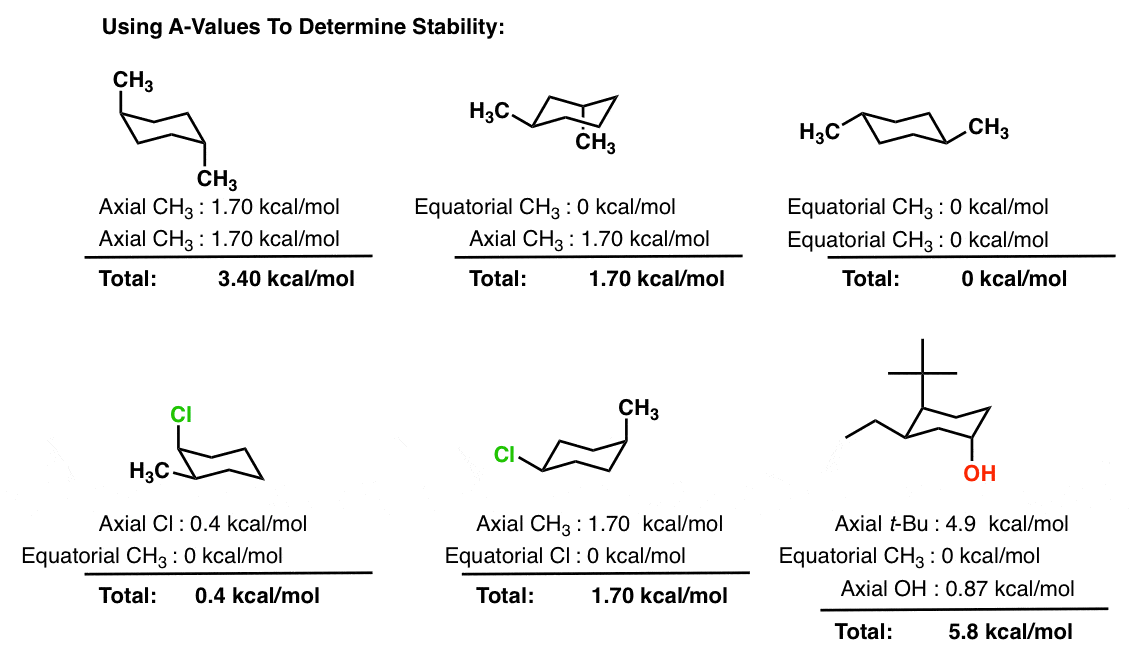
3. Example: Determining The Most Stable Conformation Of cis- And trans– 1,2-Dimethylcyclohexane
That’s nice, you might say, but when might we ever want to do that? The key example is when we are examining two chair conformers of the same molecule. A-values are essential in helping us figure out which one is most stable.
Here’s an example of the type of question we might be asked: draw the two chair conformations of cis-1,2-dimethylcyclohexane and trans-1,2-dimethylcyclohexane, and determine which is most stable.
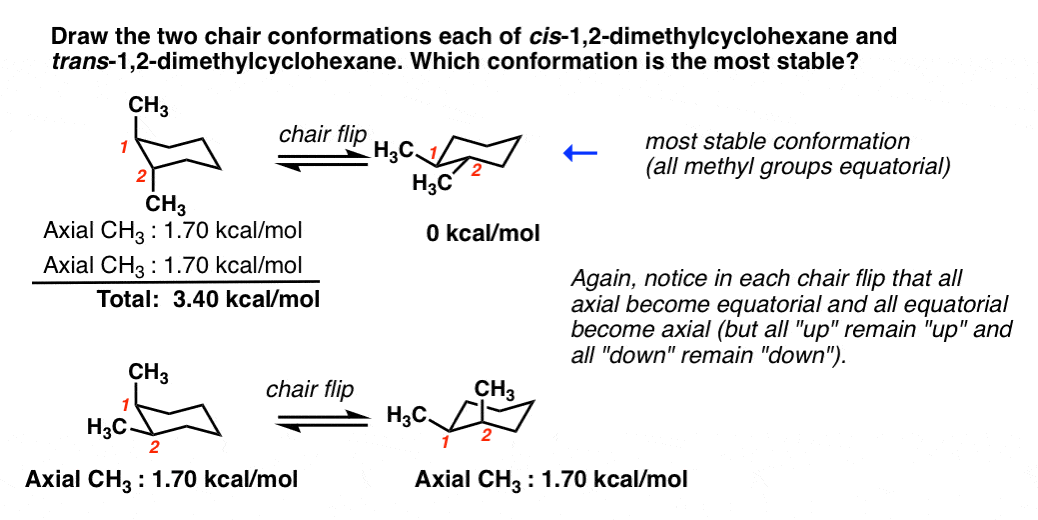
- Here, I’ve started by drawing the conformer of trans-1,2-dimethylcyclohexane where both CH3 groups are axial (remember – it’s trans because one group is up and one group is down).
- The two axial methyl groups give a total of 3.4 kcal/mol of torsional strain.
- A chair flip converts all axial groups to equatorial and vice versa (but all “up” groups remain “up” and all “down” groups remain “down”! ) giving us a conformer where both methyl groups are now equatorial (and therefore do not contribute any strain).
- Therefore the di-equatorial conformer is favoured by 3.4 kcal/mol. [If we wanted to, we could also figure out the equilibrium constant here: K is about 340, giving a ratio 99.6: 1 in favour of the di-equatorial conformer.]
- In the case of cis-1,2-dimethylcyclohexane, I’ve started by drawing an axial CH3 at C-1 and an equatorial CH3 at C-2 (note that my designation of C-1 and C-2 is completely arbitrary). This has a strain energy of 1.70 kcal/mol due to the single axial CH3.
- When we do the chair flip, we convert all axial groups to equatorial and all equatorial to axial, giving us…. a new chair which still has one methyl group equatorial and one axial! The same energy, in other words (1.70 kcal/mol). [The equilibrium constant here is 1, giving a 50:50 ratio]
4. To Determine Chair Conformation Stability, Add Up The A-Values For Each Axial Substituent. The Lower The Number The More Stable It Is
Now that we’ve drawn all four possibilities, we can rank them in order of stability if we want, and then determine that for the two isomers of 1,2-dimethylcylohexane, the di-equatorial conformer of trans-1,2-dimethylcyclohexane is the most stable.

5. Summary: Chair Conformation Stability
In the next post we’re going to talk about fused cyclohexane rings, and ask how we can apply what we’ve already learned to understand more about the stability of the conformers of these molecules.
Notes
Related Articles
- Ranking The Bulkiness Of Substituents On Cyclohexanes: “A-Values”
- Fused Rings – Cis-Decalin and Trans-Decalin
- Naming Bicyclic Compounds – Fused, Bridged, and Spiro
- Bredt’s Rule (And Summary of Cycloalkanes)
- The Cyclohexane Chair Flip – Energy Diagram
- The Cyclohexane Chair Flip – Energy Diagram
- Cycloalkanes Practice Problems (MOC Membership)
Note 1. One key exception to the “A values are additive” assumption is 1,2-di-t-butyl cyclohexane, in which the trans form is actually less stable than the cis despite the fact that both groups are equatorial in the trans. That’s because the two t-butyl groups are held together so closely in space that there is significant “1,2” strain (Van der Waals strain). [Note: it turns out in the trans isomer, the diaxial conformation is favored by 6.2 kcal/mol ! see the References section. ]
Another exception is the amino alcohol below. What force might be responsible for the fact that the axial conformer is favoured in equilibrium conditions?
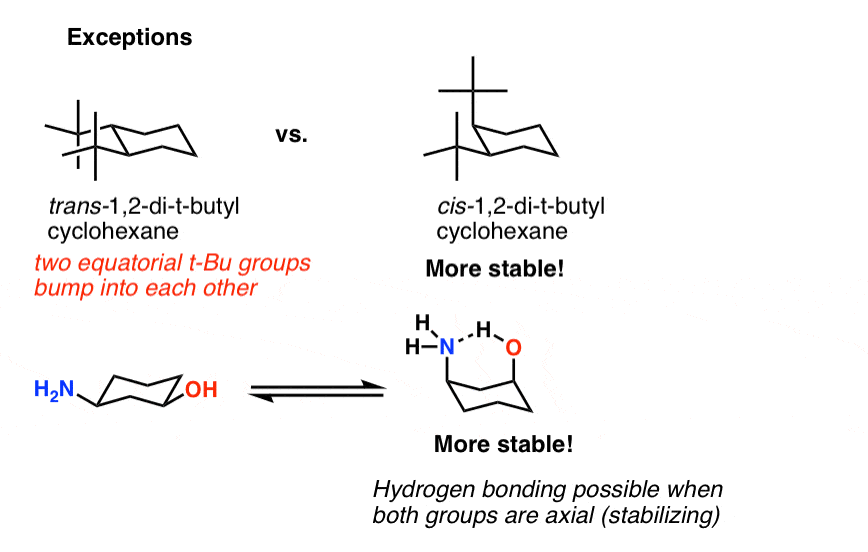
Quiz Yourself!
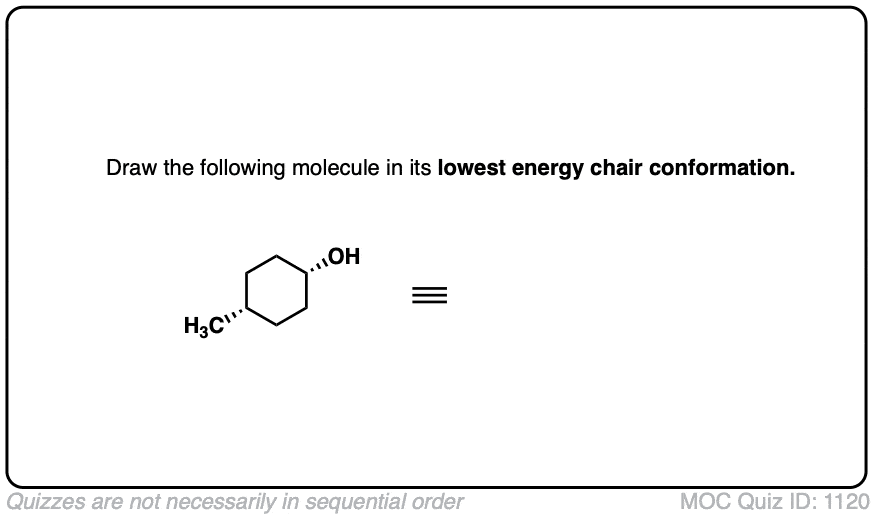 Click to Flip
Click to Flip
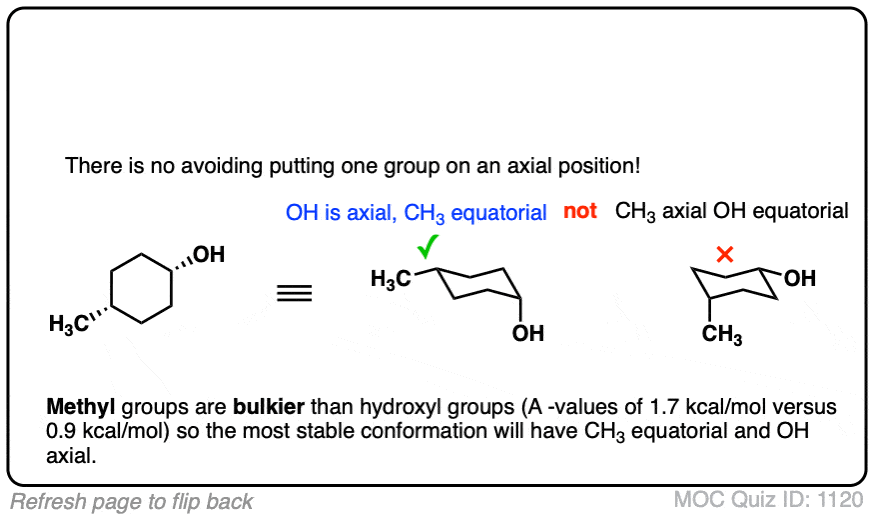
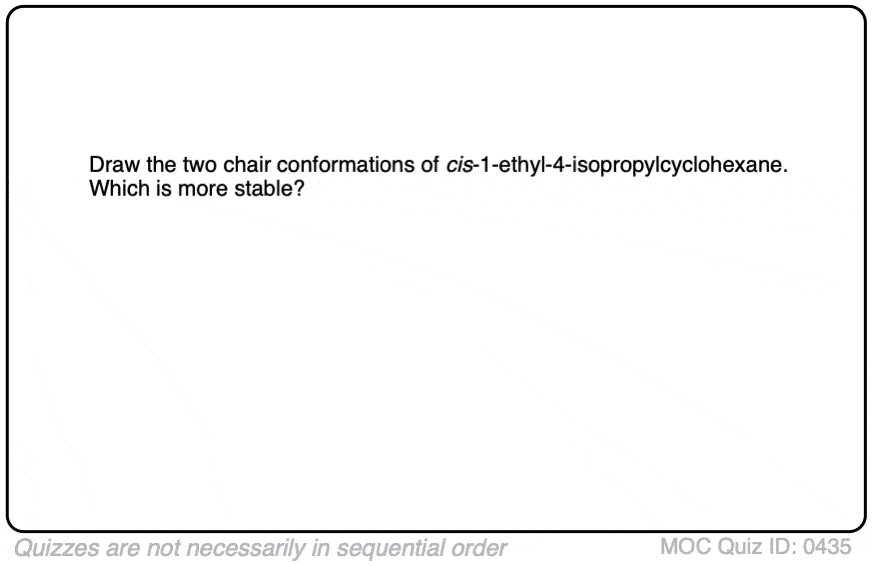 Click to Flip
Click to Flip
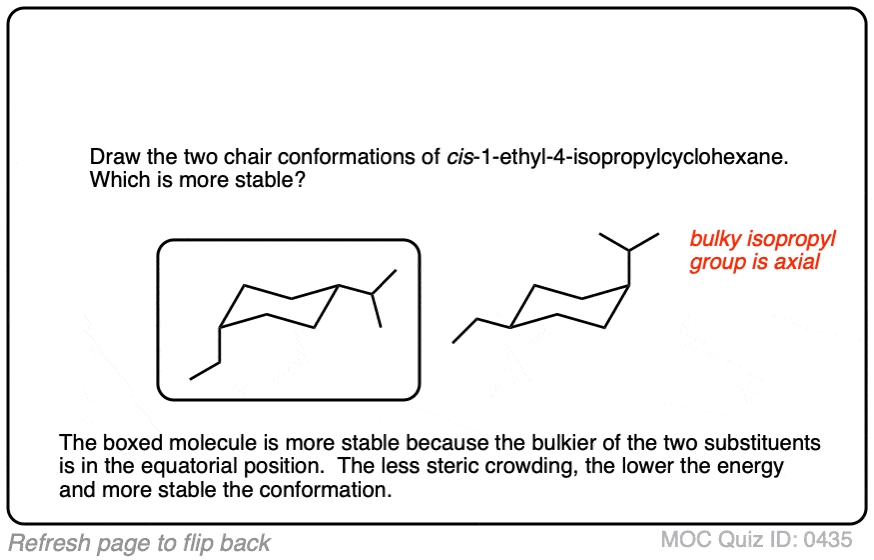
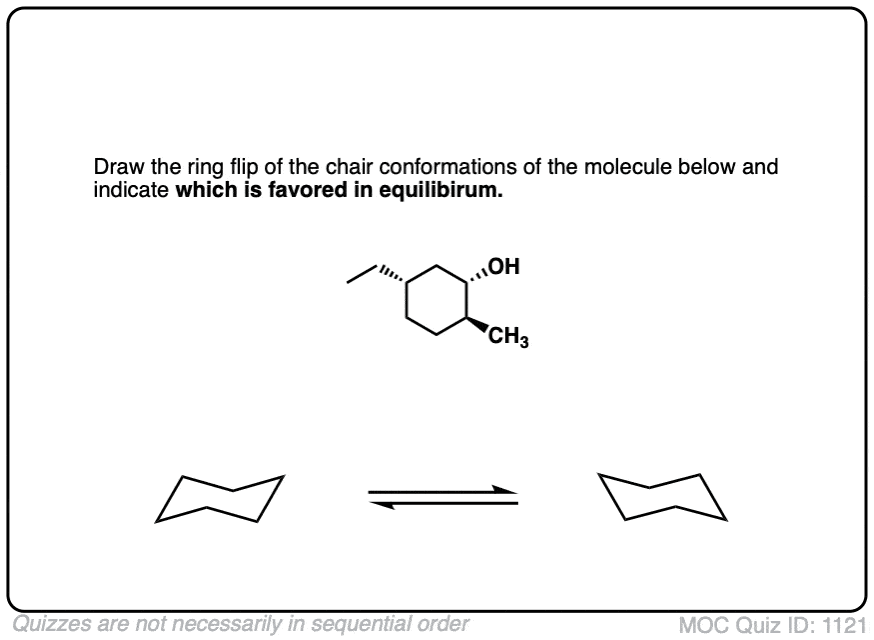 Click to Flip
Click to Flip
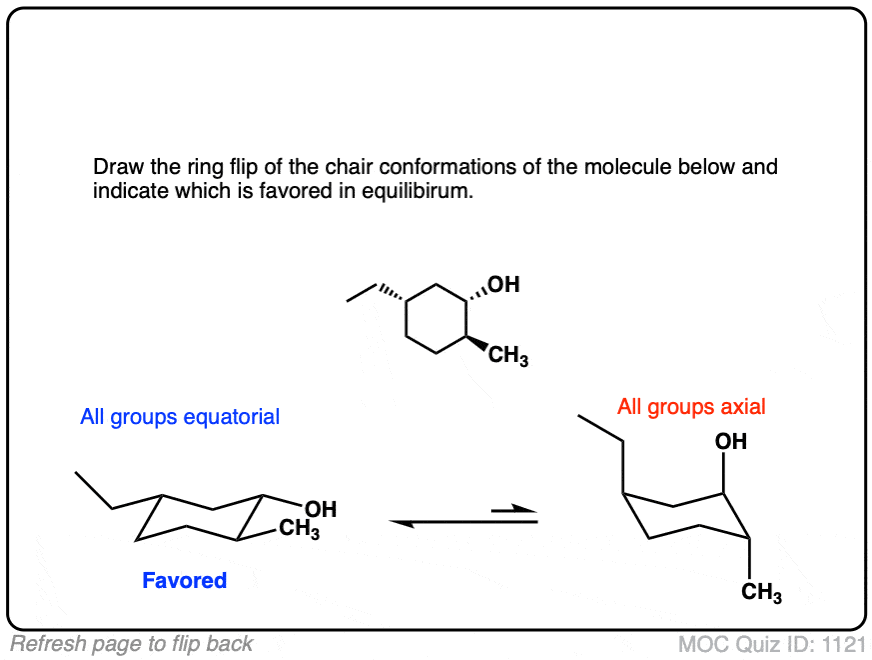
(Advanced) References and Further Reading
This is a topic commonly taught to undergraduates in Organic Chemistry. A-values are empirically derived and denote the thermodynamic preference for a substituent to be in the axial or equatorial position in cyclohexane. A-values can be added, and the total energy thus derived gives the difference in free energy between the all-axial and all-equatorial conformations.
- Neighboring Carbon and Hydrogen. XIX. t-Butylcyclohexyl Derivatives. Quantitative Conformational Analysis
S. Winstein and N. J. Holness
Journal of the American Chemical Society 1955, 77 (21), 5562-5578
DOI: 10.1021/ja01626a037
An early paper on the determination of A-values (see Table XII) through kinetic (solvolytic) measurements, which is what Prof. Winstein was well known for. The introduction features a nice summary of how A-values are determined, and later on, Prof. Winstein states “The energy quantity by which a t-butyl group favors the equatorial position is sufficiently large to guarantee conformational homogeneity to most 4-t-butylcyclohexyl derivatives”, in agreement with what is commonly taught in organic chemistry classes today. - Conformational analysis. 32. Conformational energies of methyl sulfide, methyl sulfoxide, and methyl sulfone groups
Ernest L. Eliel and Duraisamy Kandasamy
The Journal of Organic Chemistry 1976, 41 (24), 3899-3904
DOI: 1021/jo00886a026
This paper uses the additivity of A-values to determine the A-values of -SCH3, -SOCH3, and -SO2CH3 (Table IV). - The gauche interaction in trans-1,2-dimethylcyclohexane
Muthiah Manoharan and Ernest L. Eliel
Tetrahedron Lett. 1983, 24 (5), 453-456
DOI: 10.1016/S0040-4039(00)81435-5
Although this is generally not covered in introductory organic chemistry, one complication with employing A-values is that groups are on adjacent carbons (as in 1,2-dimethylcyclohexane) can undergo steric repulsion through so-called “gauche interactions”. In this paper, the gauche interaction in trans-1,2-dimethylcyclohexane is calculated to be 0.74 kcal/mol. - Conformational analysis. LVII. The calculation of the conformational structures of hydrocarbons by the Westheimer-Hendrickson-Wiberg method
Norman L. Allinger, Mary Ann Miller, Frederic A. Van Catledge, and Jerry A. Hirsch
Journal of the American Chemical Society 1967, 89 (17), 4345-4357
DOI: 1021/ja00993a017
Tables V-VII in this paper contain conformation energies of disubstituted cyclohexanes, which can be derived from adding the respective A-values. - Conformational Studies. VII.1 p-Menthane-2,5-diols and the Relative “Size” of the Isopropyl Group
Robert D. Stolow
Journal of the American Chemical Society 1964, 86 (11), 2170-2173
DOI: 1021/ja01065a013
1,2-disubstituted cyclohexanes do not add neatly due to repulsive interactions from the groups being so close to each other. - Steric Interactions in Organic Chemistry: Spatial Requirements of Substituents
Hans Förster, Prof. Dr. Fritz Vögtle
Angew. Chem. Int. Ed. 1977, 16 (7), 429-441
DOI: 10.1002/anie.197704291 - Conformational analysis. LXXVIII. The conformation of phenylcyclohexane, and related molecules
L. Allinger and M. T. Tribble
Tet. Lett. 1971, 12 (35), 3259-3262
DOI: 10.1016/S0040-4039(01)97150-3
Oddly enough, in certain phenylcyclohexanes, the phenyl group prefers to be axial, and this paper investigates that using computational methods. - Janus face all‐cis 1,2,4,5‐tetrakis(trifluoromethyl)‐ and all‐cis 1,2,3,4,5,6‐hexakis(trifluoromethyl)‐ cyclohexanes
David O’Hagan, Cihang Yu, Agnes Kütt, Gerd-Volker Röschenthaler, Tomas Lebl, David B. Cordes, Alexandra M. Z. Slawin, Michael Bűhl
Angew Chem. Int. Ed. 2020, Accepted Article
DOI: 10.1002/anie.202008662
This recently published paper is on the synthesis of 1,2,3,4,5,6-hexakis(trifluoromethyl)-cyclohexane. Computational analysis shows that it has a barrier to interconversion of approx. 27.1 kcal/mol. - Conformational Study of cis-1,4-Di-tert-butylcyclohexane by Dynamic NMR Spectroscopy and Computational Methods.
Gurvinder Gill, Diwakar M. Pawar, and Eric A. Noe
J. Org. Chem. 2005, 70, 10726-10731
DOI: 10.1021/jo051654z
Although mainly a study of 1,4-Di-t-butylcyclohexane, this paper also presents calculations for comparing the energies of diaxial and diequatorial trans-1,2-Di-t-butylcyclohexane, and finds that the diaxial conformer is more stable than the diequatorial conformer by about 6.2 kcal/mol! Interestingly the twist-boat conformer of this molecule is only slightly lower in energy (0.5 kcal/mol).
00 General Chemistry Review
01 Bonding, Structure, and Resonance
- How Do We Know Methane (CH4) Is Tetrahedral?
- Hybrid Orbitals and Hybridization
- How To Determine Hybridization: A Shortcut
- Orbital Hybridization And Bond Strengths
- Sigma bonds come in six varieties: Pi bonds come in one
- A Key Skill: How to Calculate Formal Charge
- The Four Intermolecular Forces and How They Affect Boiling Points
- 3 Trends That Affect Boiling Points
- How To Use Electronegativity To Determine Electron Density (and why NOT to trust formal charge)
- Introduction to Resonance
- How To Use Curved Arrows To Interchange Resonance Forms
- Evaluating Resonance Forms (1) - The Rule of Least Charges
- How To Find The Best Resonance Structure By Applying Electronegativity
- Evaluating Resonance Structures With Negative Charges
- Evaluating Resonance Structures With Positive Charge
- Exploring Resonance: Pi-Donation
- Exploring Resonance: Pi-acceptors
- In Summary: Evaluating Resonance Structures
- Drawing Resonance Structures: 3 Common Mistakes To Avoid
- How to apply electronegativity and resonance to understand reactivity
- Bond Hybridization Practice
- Structure and Bonding Practice Quizzes
- Resonance Structures Practice
02 Acid Base Reactions
- Introduction to Acid-Base Reactions
- Acid Base Reactions In Organic Chemistry
- The Stronger The Acid, The Weaker The Conjugate Base
- Walkthrough of Acid-Base Reactions (3) - Acidity Trends
- Five Key Factors That Influence Acidity
- Acid-Base Reactions: Introducing Ka and pKa
- How to Use a pKa Table
- The pKa Table Is Your Friend
- A Handy Rule of Thumb for Acid-Base Reactions
- Acid Base Reactions Are Fast
- pKa Values Span 60 Orders Of Magnitude
- How Protonation and Deprotonation Affect Reactivity
- Acid Base Practice Problems
03 Alkanes and Nomenclature
- Meet the (Most Important) Functional Groups
- Condensed Formulas: Deciphering What the Brackets Mean
- Hidden Hydrogens, Hidden Lone Pairs, Hidden Counterions
- Don't Be Futyl, Learn The Butyls
- Primary, Secondary, Tertiary, Quaternary In Organic Chemistry
- Branching, and Its Affect On Melting and Boiling Points
- The Many, Many Ways of Drawing Butane
- Wedge And Dash Convention For Tetrahedral Carbon
- Common Mistakes in Organic Chemistry: Pentavalent Carbon
- Table of Functional Group Priorities for Nomenclature
- Summary Sheet - Alkane Nomenclature
- Organic Chemistry IUPAC Nomenclature Demystified With A Simple Puzzle Piece Approach
- Boiling Point Quizzes
- Organic Chemistry Nomenclature Quizzes
04 Conformations and Cycloalkanes
- Staggered vs Eclipsed Conformations of Ethane
- Conformational Isomers of Propane
- Newman Projection of Butane (and Gauche Conformation)
- Introduction to Cycloalkanes
- Geometric Isomers In Small Rings: Cis And Trans Cycloalkanes
- Calculation of Ring Strain In Cycloalkanes
- Cycloalkanes - Ring Strain In Cyclopropane And Cyclobutane
- Cyclohexane Conformations
- Cyclohexane Chair Conformation: An Aerial Tour
- How To Draw The Cyclohexane Chair Conformation
- The Cyclohexane Chair Flip
- The Cyclohexane Chair Flip - Energy Diagram
- Substituted Cyclohexanes - Axial vs Equatorial
- Ranking The Bulkiness Of Substituents On Cyclohexanes: "A-Values"
- Cyclohexane Chair Conformation Stability: Which One Is Lower Energy?
- Fused Rings - Cis-Decalin and Trans-Decalin
- Naming Bicyclic Compounds - Fused, Bridged, and Spiro
- Bredt's Rule (And Summary of Cycloalkanes)
- Newman Projection Practice
- Cycloalkanes Practice Problems
05 A Primer On Organic Reactions
- The Most Important Question To Ask When Learning a New Reaction
- Curved Arrows (for reactions)
- Nucleophiles and Electrophiles
- The Three Classes of Nucleophiles
- Nucleophilicity vs. Basicity
- What Makes A Good Nucleophile?
- What Makes A Good Leaving Group?
- 3 Factors That Stabilize Carbocations
- Equilibrium and Energy Relationships
- 7 Factors that stabilize negative charge in organic chemistry
- 7 Factors That Stabilize Positive Charge in Organic Chemistry
- What's a Transition State?
- Hammond's Postulate
- Learning Organic Chemistry Reactions: A Checklist (PDF)
- Introduction to Oxidative Cleavage Reactions
06 Free Radical Reactions
- Bond Dissociation Energies = Homolytic Cleavage
- Free Radical Reactions
- 3 Factors That Stabilize Free Radicals
- What Factors Destabilize Free Radicals?
- Bond Strengths And Radical Stability
- Free Radical Initiation: Why Is "Light" Or "Heat" Required?
- Initiation, Propagation, Termination
- Monochlorination Products Of Propane, Pentane, And Other Alkanes
- Selectivity In Free Radical Reactions
- Selectivity in Free Radical Reactions: Bromination vs. Chlorination
- Halogenation At Tiffany's
- Allylic Bromination
- Bonus Topic: Allylic Rearrangements
- In Summary: Free Radicals
- Synthesis (2) - Reactions of Alkanes
- Free Radicals Practice Quizzes
07 Stereochemistry and Chirality
- Types of Isomers: Constitutional Isomers, Stereoisomers, Enantiomers, and Diastereomers
- How To Draw The Enantiomer Of A Chiral Molecule
- How To Draw A Bond Rotation
- Introduction to Assigning (R) and (S): The Cahn-Ingold-Prelog Rules
- Assigning Cahn-Ingold-Prelog (CIP) Priorities (2) - The Method of Dots
- Enantiomers vs Diastereomers vs The Same? Two Methods For Solving Problems
- Assigning R/S To Newman Projections (And Converting Newman To Line Diagrams)
- How To Determine R and S Configurations On A Fischer Projection
- The Meso Trap
- Optical Rotation, Optical Activity, and Specific Rotation
- Optical Purity and Enantiomeric Excess
- What's a Racemic Mixture?
- Chiral Allenes And Chiral Axes
- Stereochemistry Practice Problems and Quizzes
08 Substitution Reactions
- Nucleophilic Substitution Reactions - Introduction
- Two Types of Nucleophilic Substitution Reactions
- The SN2 Mechanism
- Why the SN2 Reaction Is Powerful
- The SN1 Mechanism
- The Conjugate Acid Is A Better Leaving Group
- Comparing the SN1 and SN2 Reactions
- Polar Protic? Polar Aprotic? Nonpolar? All About Solvents
- Steric Hindrance is Like a Fat Goalie
- Common Blind Spot: Intramolecular Reactions
- Substitution Practice - SN1
- Substitution Practice - SN2
09 Elimination Reactions
- Elimination Reactions (1): Introduction And The Key Pattern
- Elimination Reactions (2): The Zaitsev Rule
- Elimination Reactions Are Favored By Heat
- Two Elimination Reaction Patterns
- The E1 Reaction
- The E2 Mechanism
- E1 vs E2: Comparing the E1 and E2 Reactions
- Antiperiplanar Relationships: The E2 Reaction and Cyclohexane Rings
- Bulky Bases in Elimination Reactions
- Comparing the E1 vs SN1 Reactions
- Elimination (E1) Reactions With Rearrangements
- E1cB - Elimination (Unimolecular) Conjugate Base
- Elimination (E1) Practice Problems And Solutions
- Elimination (E2) Practice Problems and Solutions
10 Rearrangements
11 SN1/SN2/E1/E2 Decision
- Identifying Where Substitution and Elimination Reactions Happen
- Deciding SN1/SN2/E1/E2 (1) - The Substrate
- Deciding SN1/SN2/E1/E2 (2) - The Nucleophile/Base
- SN1 vs E1 and SN2 vs E2 : The Temperature
- Deciding SN1/SN2/E1/E2 - The Solvent
- Wrapup: The Key Factors For Determining SN1/SN2/E1/E2
- Alkyl Halide Reaction Map And Summary
- SN1 SN2 E1 E2 Practice Problems
12 Alkene Reactions
- E and Z Notation For Alkenes (+ Cis/Trans)
- Alkene Stability
- Alkene Addition Reactions: "Regioselectivity" and "Stereoselectivity" (Syn/Anti)
- Stereoselective and Stereospecific Reactions
- Hydrohalogenation of Alkenes and Markovnikov's Rule
- Hydration of Alkenes With Aqueous Acid
- Rearrangements in Alkene Addition Reactions
- Halogenation of Alkenes and Halohydrin Formation
- Oxymercuration Demercuration of Alkenes
- Hydroboration Oxidation of Alkenes
- m-CPBA (meta-chloroperoxybenzoic acid)
- OsO4 (Osmium Tetroxide) for Dihydroxylation of Alkenes
- Palladium on Carbon (Pd/C) for Catalytic Hydrogenation of Alkenes
- Cyclopropanation of Alkenes
- A Fourth Alkene Addition Pattern - Free Radical Addition
- Alkene Reactions: Ozonolysis
- Summary: Three Key Families Of Alkene Reaction Mechanisms
- Synthesis (4) - Alkene Reaction Map, Including Alkyl Halide Reactions
- Alkene Reactions Practice Problems
13 Alkyne Reactions
- Acetylides from Alkynes, And Substitution Reactions of Acetylides
- Partial Reduction of Alkynes With Lindlar's Catalyst
- Partial Reduction of Alkynes With Na/NH3 To Obtain Trans Alkenes
- Alkyne Hydroboration With "R2BH"
- Hydration and Oxymercuration of Alkynes
- Hydrohalogenation of Alkynes
- Alkyne Halogenation: Bromination, Chlorination, and Iodination of Alkynes
- Alkyne Reactions - The "Concerted" Pathway
- Alkenes To Alkynes Via Halogenation And Elimination Reactions
- Alkynes Are A Blank Canvas
- Synthesis (5) - Reactions of Alkynes
- Alkyne Reactions Practice Problems With Answers
14 Alcohols, Epoxides and Ethers
- Alcohols - Nomenclature and Properties
- Alcohols Can Act As Acids Or Bases (And Why It Matters)
- Alcohols - Acidity and Basicity
- The Williamson Ether Synthesis
- Ethers From Alkenes, Tertiary Alkyl Halides and Alkoxymercuration
- Alcohols To Ethers via Acid Catalysis
- Cleavage Of Ethers With Acid
- Epoxides - The Outlier Of The Ether Family
- Opening of Epoxides With Acid
- Epoxide Ring Opening With Base
- Making Alkyl Halides From Alcohols
- Tosylates And Mesylates
- PBr3 and SOCl2
- Elimination Reactions of Alcohols
- Elimination of Alcohols To Alkenes With POCl3
- Alcohol Oxidation: "Strong" and "Weak" Oxidants
- Demystifying The Mechanisms of Alcohol Oxidations
- Protecting Groups For Alcohols
- Thiols And Thioethers
- Calculating the oxidation state of a carbon
- Oxidation and Reduction in Organic Chemistry
- Oxidation Ladders
- SOCl2 Mechanism For Alcohols To Alkyl Halides: SN2 versus SNi
- Alcohol Reactions Roadmap (PDF)
- Alcohol Reaction Practice Problems
- Epoxide Reaction Quizzes
- Oxidation and Reduction Practice Quizzes
15 Organometallics
- What's An Organometallic?
- Formation of Grignard and Organolithium Reagents
- Organometallics Are Strong Bases
- Reactions of Grignard Reagents
- Protecting Groups In Grignard Reactions
- Synthesis Problems Involving Grignard Reagents
- Grignard Reactions And Synthesis (2)
- Organocuprates (Gilman Reagents): How They're Made
- Gilman Reagents (Organocuprates): What They're Used For
- The Heck, Suzuki, and Olefin Metathesis Reactions (And Why They Don't Belong In Most Introductory Organic Chemistry Courses)
- Reaction Map: Reactions of Organometallics
- Grignard Practice Problems
16 Spectroscopy
- Degrees of Unsaturation (or IHD, Index of Hydrogen Deficiency)
- Conjugation And Color (+ How Bleach Works)
- Introduction To UV-Vis Spectroscopy
- UV-Vis Spectroscopy: Absorbance of Carbonyls
- UV-Vis Spectroscopy: Practice Questions
- Bond Vibrations, Infrared Spectroscopy, and the "Ball and Spring" Model
- Infrared Spectroscopy: A Quick Primer On Interpreting Spectra
- IR Spectroscopy: 4 Practice Problems
- 1H NMR: How Many Signals?
- Homotopic, Enantiotopic, Diastereotopic
- Diastereotopic Protons in 1H NMR Spectroscopy: Examples
- 13-C NMR - How Many Signals
- Liquid Gold: Pheromones In Doe Urine
- Natural Product Isolation (1) - Extraction
- Natural Product Isolation (2) - Purification Techniques, An Overview
- Structure Determination Case Study: Deer Tarsal Gland Pheromone
17 Dienes and MO Theory
- What To Expect In Organic Chemistry 2
- Are these molecules conjugated?
- Conjugation And Resonance In Organic Chemistry
- Bonding And Antibonding Pi Orbitals
- Molecular Orbitals of The Allyl Cation, Allyl Radical, and Allyl Anion
- Pi Molecular Orbitals of Butadiene
- Reactions of Dienes: 1,2 and 1,4 Addition
- Thermodynamic and Kinetic Products
- More On 1,2 and 1,4 Additions To Dienes
- s-cis and s-trans
- The Diels-Alder Reaction
- Cyclic Dienes and Dienophiles in the Diels-Alder Reaction
- Stereochemistry of the Diels-Alder Reaction
- Exo vs Endo Products In The Diels Alder: How To Tell Them Apart
- HOMO and LUMO In the Diels Alder Reaction
- Why Are Endo vs Exo Products Favored in the Diels-Alder Reaction?
- Diels-Alder Reaction: Kinetic and Thermodynamic Control
- The Retro Diels-Alder Reaction
- The Intramolecular Diels Alder Reaction
- Regiochemistry In The Diels-Alder Reaction
- The Cope and Claisen Rearrangements
- Electrocyclic Reactions
- Electrocyclic Ring Opening And Closure (2) - Six (or Eight) Pi Electrons
- Diels Alder Practice Problems
- Molecular Orbital Theory Practice
18 Aromaticity
- Introduction To Aromaticity
- Rules For Aromaticity
- Huckel's Rule: What Does 4n+2 Mean?
- Aromatic, Non-Aromatic, or Antiaromatic? Some Practice Problems
- Antiaromatic Compounds and Antiaromaticity
- The Pi Molecular Orbitals of Benzene
- The Pi Molecular Orbitals of Cyclobutadiene
- Frost Circles
- Aromaticity Practice Quizzes
19 Reactions of Aromatic Molecules
- Electrophilic Aromatic Substitution: Introduction
- Activating and Deactivating Groups In Electrophilic Aromatic Substitution
- Electrophilic Aromatic Substitution - The Mechanism
- Ortho-, Para- and Meta- Directors in Electrophilic Aromatic Substitution
- Understanding Ortho, Para, and Meta Directors
- Why are halogens ortho- para- directors?
- Disubstituted Benzenes: The Strongest Electron-Donor "Wins"
- Electrophilic Aromatic Substitutions (1) - Halogenation of Benzene
- Electrophilic Aromatic Substitutions (2) - Nitration and Sulfonation
- EAS Reactions (3) - Friedel-Crafts Acylation and Friedel-Crafts Alkylation
- Intramolecular Friedel-Crafts Reactions
- Nucleophilic Aromatic Substitution (NAS)
- Nucleophilic Aromatic Substitution (2) - The Benzyne Mechanism
- Reactions on the "Benzylic" Carbon: Bromination And Oxidation
- The Wolff-Kishner, Clemmensen, And Other Carbonyl Reductions
- More Reactions on the Aromatic Sidechain: Reduction of Nitro Groups and the Baeyer Villiger
- Aromatic Synthesis (1) - "Order Of Operations"
- Synthesis of Benzene Derivatives (2) - Polarity Reversal
- Aromatic Synthesis (3) - Sulfonyl Blocking Groups
- Birch Reduction
- Synthesis (7): Reaction Map of Benzene and Related Aromatic Compounds
- Aromatic Reactions and Synthesis Practice
- Electrophilic Aromatic Substitution Practice Problems
20 Aldehydes and Ketones
- What's The Alpha Carbon In Carbonyl Compounds?
- Nucleophilic Addition To Carbonyls
- Aldehydes and Ketones: 14 Reactions With The Same Mechanism
- Sodium Borohydride (NaBH4) Reduction of Aldehydes and Ketones
- Grignard Reagents For Addition To Aldehydes and Ketones
- Wittig Reaction
- Hydrates, Hemiacetals, and Acetals
- Imines - Properties, Formation, Reactions, and Mechanisms
- All About Enamines
- Breaking Down Carbonyl Reaction Mechanisms: Reactions of Anionic Nucleophiles (Part 2)
- Aldehydes Ketones Reaction Practice
21 Carboxylic Acid Derivatives
- Nucleophilic Acyl Substitution (With Negatively Charged Nucleophiles)
- Addition-Elimination Mechanisms With Neutral Nucleophiles (Including Acid Catalysis)
- Basic Hydrolysis of Esters - Saponification
- Transesterification
- Proton Transfer
- Fischer Esterification - Carboxylic Acid to Ester Under Acidic Conditions
- Lithium Aluminum Hydride (LiAlH4) For Reduction of Carboxylic Acid Derivatives
- LiAlH[Ot-Bu]3 For The Reduction of Acid Halides To Aldehydes
- Di-isobutyl Aluminum Hydride (DIBAL) For The Partial Reduction of Esters and Nitriles
- Amide Hydrolysis
- Thionyl Chloride (SOCl2)
- Diazomethane (CH2N2)
- Carbonyl Chemistry: Learn Six Mechanisms For the Price Of One
- Making Music With Mechanisms (PADPED)
- Carboxylic Acid Derivatives Practice Questions
22 Enols and Enolates
- Keto-Enol Tautomerism
- Enolates - Formation, Stability, and Simple Reactions
- Kinetic Versus Thermodynamic Enolates
- Aldol Addition and Condensation Reactions
- Reactions of Enols - Acid-Catalyzed Aldol, Halogenation, and Mannich Reactions
- Claisen Condensation and Dieckmann Condensation
- Decarboxylation
- The Malonic Ester and Acetoacetic Ester Synthesis
- The Michael Addition Reaction and Conjugate Addition
- The Robinson Annulation
- Haloform Reaction
- The Hell–Volhard–Zelinsky Reaction
- Enols and Enolates Practice Quizzes
23 Amines
- The Amide Functional Group: Properties, Synthesis, and Nomenclature
- Basicity of Amines And pKaH
- 5 Key Basicity Trends of Amines
- The Mesomeric Effect And Aromatic Amines
- Nucleophilicity of Amines
- Alkylation of Amines (Sucks!)
- Reductive Amination
- The Gabriel Synthesis
- Some Reactions of Azides
- The Hofmann Elimination
- The Hofmann and Curtius Rearrangements
- The Cope Elimination
- Protecting Groups for Amines - Carbamates
- The Strecker Synthesis of Amino Acids
- Introduction to Peptide Synthesis
- Reactions of Diazonium Salts: Sandmeyer and Related Reactions
- Amine Practice Questions
24 Carbohydrates
- D and L Notation For Sugars
- Pyranoses and Furanoses: Ring-Chain Tautomerism In Sugars
- What is Mutarotation?
- Reducing Sugars
- The Big Damn Post Of Carbohydrate-Related Chemistry Definitions
- The Haworth Projection
- Converting a Fischer Projection To A Haworth (And Vice Versa)
- Reactions of Sugars: Glycosylation and Protection
- The Ruff Degradation and Kiliani-Fischer Synthesis
- Isoelectric Points of Amino Acids (and How To Calculate Them)
- Carbohydrates Practice
- Amino Acid Quizzes
25 Fun and Miscellaneous
- A Gallery of Some Interesting Molecules From Nature
- Screw Organic Chemistry, I'm Just Going To Write About Cats
- On Cats, Part 1: Conformations and Configurations
- On Cats, Part 2: Cat Line Diagrams
- On Cats, Part 4: Enantiocats
- On Cats, Part 6: Stereocenters
- Organic Chemistry Is Shit
- The Organic Chemistry Behind "The Pill"
- Maybe they should call them, "Formal Wins" ?
- Why Do Organic Chemists Use Kilocalories?
- The Principle of Least Effort
- Organic Chemistry GIFS - Resonance Forms
- Reproducibility In Organic Chemistry
- What Holds The Nucleus Together?
- How Reactions Are Like Music
- Organic Chemistry and the New MCAT
26 Organic Chemistry Tips and Tricks
- Common Mistakes: Formal Charges Can Mislead
- Partial Charges Give Clues About Electron Flow
- Draw The Ugly Version First
- Organic Chemistry Study Tips: Learn the Trends
- The 8 Types of Arrows In Organic Chemistry, Explained
- Top 10 Skills To Master Before An Organic Chemistry 2 Final
- Common Mistakes with Carbonyls: Carboxylic Acids... Are Acids!
- Planning Organic Synthesis With "Reaction Maps"
- Alkene Addition Pattern #1: The "Carbocation Pathway"
- Alkene Addition Pattern #2: The "Three-Membered Ring" Pathway
- Alkene Addition Pattern #3: The "Concerted" Pathway
- Number Your Carbons!
- The 4 Major Classes of Reactions in Org 1
- How (and why) electrons flow
- Grossman's Rule
- Three Exam Tips
- A 3-Step Method For Thinking Through Synthesis Problems
- Putting It Together
- Putting Diels-Alder Products in Perspective
- The Ups and Downs of Cyclohexanes
- The Most Annoying Exceptions in Org 1 (Part 1)
- The Most Annoying Exceptions in Org 1 (Part 2)
- The Marriage May Be Bad, But the Divorce Still Costs Money
- 9 Nomenclature Conventions To Know
- Nucleophile attacks Electrophile
27 Case Studies of Successful O-Chem Students
- Success Stories: How Corina Got The The "Hard" Professor - And Got An A+ Anyway
- How Helena Aced Organic Chemistry
- From a "Drop" To B+ in Org 2 – How A Hard Working Student Turned It Around
- How Serge Aced Organic Chemistry
- Success Stories: How Zach Aced Organic Chemistry 1
- Success Stories: How Kari Went From C– to B+
- How Esther Bounced Back From a "C" To Get A's In Organic Chemistry 1 And 2
- How Tyrell Got The Highest Grade In Her Organic Chemistry Course
- This Is Why Students Use Flashcards
- Success Stories: How Stu Aced Organic Chemistry
- How John Pulled Up His Organic Chemistry Exam Grades
- Success Stories: How Nathan Aced Organic Chemistry (Without It Taking Over His Life)
- How Chris Aced Org 1 and Org 2
- Interview: How Jay Got an A+ In Organic Chemistry
- How to Do Well in Organic Chemistry: One Student's Advice
- "America's Top TA" Shares His Secrets For Teaching O-Chem
- "Organic Chemistry Is Like..." - A Few Metaphors
- How To Do Well In Organic Chemistry: Advice From A Tutor
- Guest post: "I went from being afraid of tests to actually looking forward to them".
It was really helpful thanks a lot
The equatorial substituents including methyl group can also have significant gauche interactions with each other. For example, the two equatorial methyl groups in trans-1,2-dimethylcyclohexane (equatorial conformation). The gauhe interaction between these two methyl group is 0.9 kCal/mol instead of zero kCal/mol in this post. Below includes more examples for your reference.
https://sites.science.oregonstate.edu/~gablek/CH334/Chapter4/bare_Problem_LG9.htm
Yes! That is an excellent point. This is addressed in Reference 3. The gauche interaction in trans 1,2-dimethylcyclohexane is 0.74 kcal/mol. https://www.sciencedirect.com/science/article/abs/pii/S0040403900814355
Thank you. Great work with your blog!
Hi Andrea! Alluding to your earlier comment, there is likely a solvent effect because of differences in dipole moment. From Eliel’s “Stereochemistry of Organic Compounds”, page 673 I see that the dipole moment of cis 1,2-dichlorocyclopropane is 3.10 and the dipole moment of the trans is 2.63 . This would suggest that in less polar solvents (e.g. pentane, hexane) the trans would be favored so as to minimize the dipole moment.
I seem to recall some discussion of the solvent dependence of A-values from one of Eliels papers but I can’t find it at the moment!
In March’s organic chemistry (7th edition chapter 4) is pointed out that for 1,2-dihalides cyclohexanes there is a preference for the diaxial form. Why not the equatorial?
What about the effect of different solvents on the stabilization for substituted cyclohexane?
Thank you so much for the explanation!
I seem to have pondered too much over the molecule as I have another question.
Will there be van der Waals strain in the case of bulky equatorial groups lying distant from one another, say in 1,3 or 1,4 positions? Will the diaxial conformer still be favoured?
In case of trans 1,2-di-t-butyl cyclohexane, if we make a model of the compound, we see that the two tertiary butyl groups aren’t bumping at one another. Rather, they are pointing away from each other. So, shouldn’t the cis conformer be more stable?
Thank you for the helpful content.
If we make a model of the trans-1,2-di-t-butylcyclohexane, we see that the two tertiary butyl groups aren’t bumping onto each other. Rather, they’re pointing away from one another. So, shouldn’t the conformer be more stable than the cis conformer?
Also, it will be really helpful if you could tell whether the net dipole moment of the molecule plays a part in its stability. eg., in case of 1,2-dibromocyclohexane where the Br groups are both in axial positions, the net dipole moment of the molecule is zero but the A value is 0.89 Kcal/mol where as in a case where both Br are in equatorial positions, the molecule has a net dipole moment but zero A value.
I learn a lot from your content.
Thanks.
Yes, with extremely bulky equatorial groups van der Waals strain can arise, which will push the equilibrium toward the diaxial conformer. In the case of trans 1,2-di-butyl cyclohexane, the diaxial conformer was calculated to be 6.2 kcal/mol more stable than the diequatorial conformer. Interestingly, a twist-boat conformation was very close to it in energy. J. Org. Chem. 2005, 70, 10726-10731 . https://pubs.acs.org/doi/pdf/10.1021/jo051654z?rand=0l523xw6
In the case of dipole moments, you could test that by measuring conformational preferences as a function of polarity of the solvent. This can be done in NMR, for example. I am sure it’s been done but I don’t have a literature reference for you at the moment.
thanks to @curiouswavefunction , I found an example of a difluoro compound which strongly favors the diaxial conformer in aqueous solution (95%) but the diaxial ratio drops off as solvent polarity decreases. See here: https://pubs.acs.org/doi/10.1021/ja9934504
I looked into the effects of solvent on A values (i.e. delta G values) for halocycloalkanes. Here’s what Ernest L. Eliel has to say: “The —AG° values are: 0.15 kcal/mol for fluorine, 0.43 kcal/mol for chlorine, and 0.37 kcal/mol for
bromine, and are remarkably independent of solvent. ” . See https://pubs.acs.org/doi/pdf/10.1021/ja01005a024
Hey this probably seems dumb, but I’m trying the find the ratio of the two chairs and I can’t find anywhere that actually solves through the delta G of formation equation to solve for K. I know its probably a simple calculation but I don’t understand how to take a single number and turn it into the ratio of products. May be helpful for others in the future. Thanks for the help with the other information though.
That is a great question. Thanks for the suggestion, I should put this in.
It was really helpful .Also the content was straight to the point .Thanx a lot
OK. Thank you very much Nisarg.
Hi James, I realized that two of the conformers in the ranking of the 4 are identical. Can you take a look to see what I’m referring to?
Thanks!
Thanks for pointing that out. Fixed!!
For the ranking one, why is the second the same as the fourth?
fixed!
This was very helpful to me. I appreciate this because i am studying organic chemistry right now.
Great, thanks for reading Dominic.
Hey James
I wonder if there is a minor mistake in the diagram of “ranking the four conformers”. The second one should be equatorial+axial.
Thanks for all these amazing materials!
fixed!
This was really really helpful to me. I appreciate it. Keep up your good jobs!
“despite the fact that both groups are equatorial in the cis”. In the trans, actually! but great post, as usual.
shoot! fixed. Thanks for the keen eye, as always.